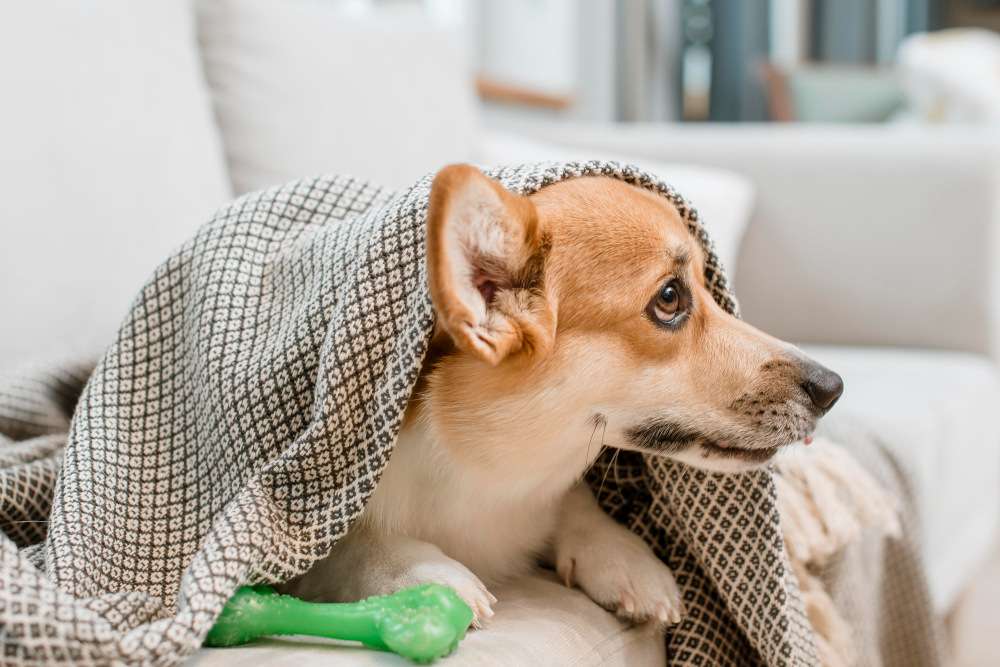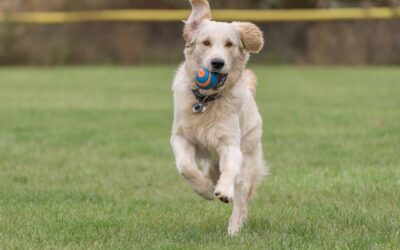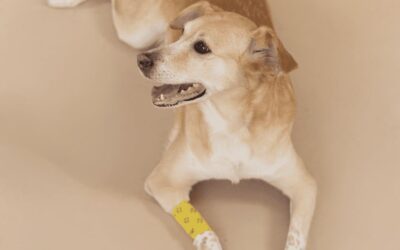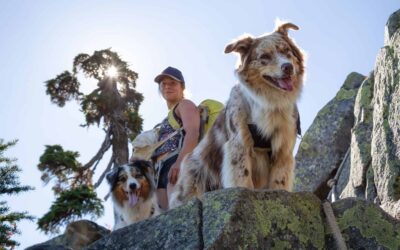Lumps & Bumps on Dogs [Causes, Types & Treatment]

Updated November 14, 2025
Just like people, dogs can develop various types of skin lumps, and staying aware of these changes is a big part of helping your dog stay healthy and comfortable. Some lumps are harmless, while others may need a bit more attention. Understanding what to look for and knowing when to consult a vet can help you stay proactive without unnecessary worry.
Whether you’re new to having a dog or a seasoned pet parent, this guide will walk you through the basics of different types of skin growths, signs to watch for, and when to consider seeing a vet. Additionally, we’ll explore ways to maintain your dog’s skin health, allowing you to prevent issues before they arise.
Common Causes of Lumps and Bumps in Dogs
Just like humans, dogs can develop lumps for many reasons—some minor, others requiring closer attention. Knowing what’s behind those bumps can help you feel more at ease and take proactive steps.
Lipomas (Fatty Lumps)
These are soft, squishy lumps that sit just beneath the skin. They’re one of the most common types of benign (non-cancerous) growths found in dogs, especially older ones. Lipomas usually move slightly under your fingers when touched and don’t cause pain.
Sebaceous Cysts
Think of these as small, blocked oil glands. They form firm, round bumps under the skin and sometimes release a white, thick material if they rupture. While most are harmless, they can get irritated or infected.
Infections and Abscesses
If your dog has a painful, warm, or swollen lump that appeared suddenly, it could be an abscess caused by a bite, scratch, or other injury that has become infected. These usually need veterinary attention to drain and treat the infection safely.
Other causes can include insect bites, allergic reactions, or even certain types of tumors. The key is not to panic—but to take note of any changes and talk to your vet for clarity.
What Your Vet Might Do: Diagnostic Steps
If you’ve found a new lump or bump, your vet will likely start with a simple exam and then recommend one or more of the following diagnostic tools:
Fine-Needle Aspiration (FNA)
A quick and minimally invasive test where your vet uses a small needle to collect a few cells from the lump. The sample is then examined under a microscope to help identify what type of tissue it is.
Biopsy
In some cases, your vet may remove a small sample—or the entire lump—to analyze in more detail. This gives the clearest picture of what’s going on and helps guide treatment.
Imaging (X-rays, Ultrasound, or MRI)
If the lump is deep or affecting nearby tissues, imaging helps your vet see how large it is and whether it’s spreading internally.
Common Signs and Symptoms of Skin Changes in Dogs
Monitoring skin changes is a simple yet important way to keep track of your dog’s health. While some lumps and bumps might be totally harmless, others could signal something more serious. Here’s what to look out for:
- Lumps or bumps: Skin growths come in all shapes and sizes. From small, pea-sized spots to larger, noticeable lumps, checking them regularly can help catch any changes.
- Color or texture changes: Any shifts in skin color or texture, such as redness or rough patches, may require a closer examination.
- Itching or scratching: If your dog starts scratching or licking a particular area frequently, it may indicate that they’re feeling irritated.
- Hair loss: Certain skin conditions or infections can lead to hair loss around a lump or bump.
- Oozing or crusting: If a lump is oozing or has crusted over, it may be infected.
- Unpleasant odor: A foul smell can sometimes indicate an infection or other skin issue.
:strip_icc():format(webp)/tumors-growths-and-cysts-on-dogs-4116142_FINAL-d7142ce9164d4e9183d3399a7d684788.jpg)
Source: https://www.thesprucepets.com/tumors-growths-and-cysts-on-dogs-4116142
Types of Skin Lumps and Bumps on Dogs
Here’s a rundown of the most common types of skin growths your dog might develop, plus some guidance on when to seek further help:
Benign Tumors
- Histiocytoma: Common in young dogs (<2 years), found on the head or legs, pink and fleshy; typically regress without treatment.
- Lipoma: Common in older, overweight dogs, typically found on the trunk and legs, characterized by a soft, fatty growth; no treatment is necessary unless it becomes bothersome, at which point it can be removed if problematic.
- Papilloma: Wart-like, caused by a virus, usually in young dogs, found around the mouth or eyes; may fall off naturally, but can be surgically removed if obstructive.
- Skin Tag: Connective tissue growth in skin folds, often in older dogs; harmless unless bothersome, can be surgically removed.
- Sebaceous Gland Tumor: Small lumps, common in older dogs, found on eyelids; surgical removal if bothersome.
- Meibomian Gland Tumor: Located on the eyelids, this cystic condition can cause eye irritation; removal may be performed surgically or by freezing.
- Epulis: Found in the mouth, may have a bony interior, commonly near teeth; surgical removal recommended.
- Follicular Cyst: Benign skin cyst that may become itchy or painful; may need antibiotics if infected, and can be removed if problematic.
- Perianal Adenoma: Near the anus in older unneutered males; neutering often cures, surgical removal if problematic.
- Hemangioma: Blood vessel-like tumor on sparse hair areas; treated with surgical removal.
- Nevus (Mole): Dark, raised/flat growth; removal if necessary.
- Trichoepithelioma: Cyst-like, from hair follicles, commonly on the face/trunk; surgical removal if needed.
- Cornifying Epithelioma: Horn-like growth from hair follicles; removal if causing trauma or infection.
- Basal Cell Tumor: Small, dark, usually on the head or neck; removal if bothersome
Malignant Tumors
- Angiosarcoma: Blood vessel tumor, red lumps or bruises; requires biopsy, treatment with surgery, and possibly chemotherapy.
- Basal Cell Carcinoma: Older dogs, spread to surrounding skin; surgical removal is recommended.
- Liposarcoma: Rare, in older males on chest/legs; removal with possible radiation.
- Lymphosarcoma: Rarely on skin, appears as flaky/red patches; treatment may include surgery, chemo, or radiation.
- Mast Cell Tumor: Red, raised lumps that can vary in aggression; requires surgical removal, chemotherapy, or radiation if recurrent.
- Malignant Melanoma: Lips, mouth, nail beds; fast-spreading, treated with surgery, vaccine may prolong life.
- Fibrosarcoma: Common on trunk and legs, firm or fleshy; removal is difficult, often treated with radiation or chemotherapy.
- Squamous Cell Carcinoma: Found on skin or under nails; solitary but may spread, treated with complete surgical removal.
For a more detailed explanation of the types of skin lumps in dogs, read this article, which was reviewed by Barri J. Morrison, DVM.
Treatment for Dog Lumps, Bumps, and Cysts on Dogs
As Teresa Manucy, DVM, stated in the article: “Options for treatment of a bump on a dog’s skin may include:
- Monitoring for changes
- Removal by freezing or laser treatments
- Surgical removal of the lump with or without also removing some normal tissue
- Chemotherapy
- Radiation
Keep a log where you write down:
- When you first noticed the lumps and/or bumps
- How many there are and where they are located
- The size, color, and texture
- Whether it’s moveable or seems to be fixed to underlying tissue
- Whether there is any discharge present
Take pictures and note any changes from day to day in any of these factors.
Make an appointment with your vet as soon as possible and bring your log and photos along with any questions you may have.”
Tips for Keeping Your Dog’s Skin Healthy
While lumps can be hard to prevent entirely, there are things you can do to support your dog’s skin health:
- Regular grooming: Brushing helps you spot changes early and keeps your dog’s skin and coat healthy.
- Flea and tick prevention: Use vet-approved flea and tick treatments to avoid bites and irritation.
- Good nutrition: A balanced diet promotes healthy skin and fur.
- Manage allergens: Avoid allergens in the home, like dust or certain fabrics, to keep sensitive dogs comfortable.
- Use gentle products: Choose mild, pet-safe grooming products and avoid harsh chemicals.
- Exercise and weight management: Keeping your dog fit reduces the risk of weight-related skin issues.
- Reduce stress: A calm, comforting environment can help dogs with skin sensitivities.
- Regular check-ups: Routine vet visits help you stay on top of any potential skin issues.
- Treat issues quickly: If you notice skin changes, addressing them early can prevent more serious complications.
How Can Pet Insurance Help You if Your Dog Needs Treatment?
Pet insurance can be a valuable tool in managing the costs of treating a dog’s veterinary expenses. By having a pet insurance policy in place, you can have peace of mind knowing that you can provide medical care for your furry companion without worrying about the financial burden. Pet insurance can help cover the costs of veterinary consultations, diagnostic tests, medications, and even specialized treatments if required.
Reimbursement
This method is the most common for pet insurance companies. You pay out of pocket for the veterinarian bill, and then the insurance company reimburses you for what’s covered under the insurance plan. The steps look like this.
- You pay the vet bill after your dog’s visit.
- You fill out the pet insurance claim form.
- Submit the claim form and other required documentation to the insurer.
- After the claim is approved, you will be reimbursed for eligible expenses.
What Does Odie Pet Insurance Cover?
Pet insurance covers various veterinary expenses, providing financial protection and peace of mind for pet owners. Here are the details of the coverage options offered by Odie Pet Insurance:
Illness & Injury Plan
The Illness & Injury Plan is an all-inclusive insurance plan designed to cover a wide range of medical needs for your pet. This plan includes comprehensive coverage for various illnesses, injuries, and veterinary services. Some of the covered items include:
- Veterinary exams and consultations
- Diagnostics (e.g., X-rays, lab tests)
- Prescribed medications
- Surgeries and hospitalization
- Rehabilitation, acupuncture, or chiropractic treatments
- Medically necessary supplies
- Euthanasia and cremation
The Wellness Plan
The Wellness Plan is a monthly membership that focuses on preventive care and covers routine veterinary services.
- Provides reimbursements for routine care items such as wellness visits (exams and vaccines), testing and parasite prevention, dental cleanings and at-home dental care, vitamins, supplements, and more.
- Through Odie’s partnership with Petivity, a leader in smart pet products and proactive care, Wellness Plan members can also receive reimbursements for Petivity devices and health kits, as well as eligible Purina food and supplements.
- Total reimbursement up to $700 per year.



